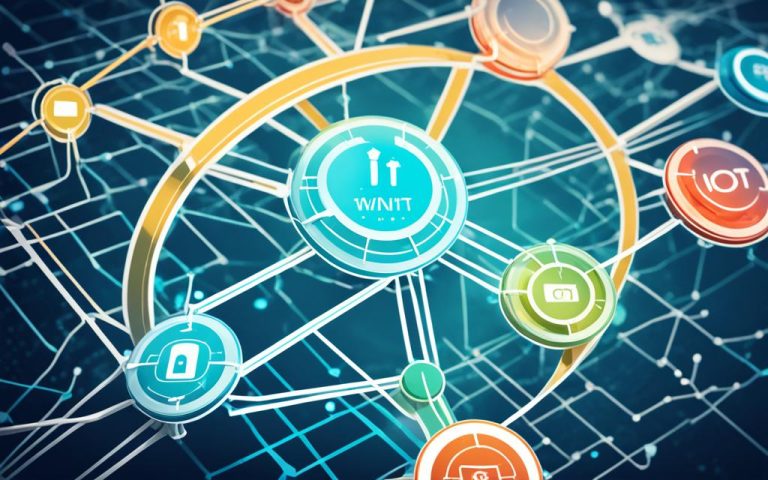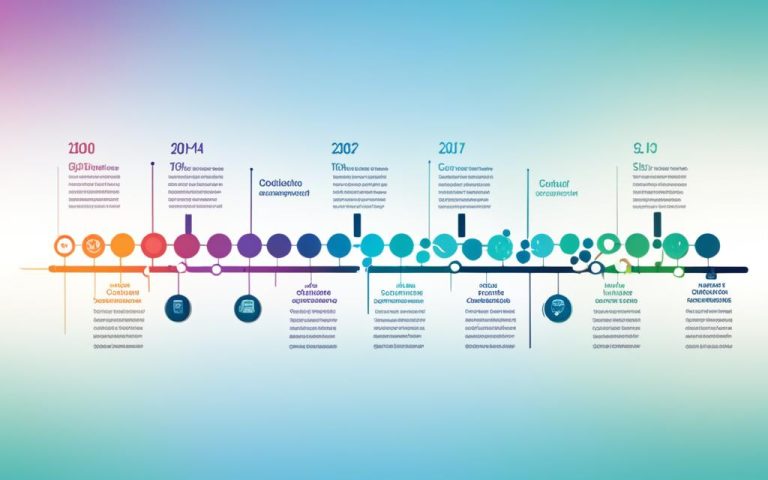The digital divide is a global issue that separates individuals and communities from the vast resources of the digital world. With approximately 2.6 billion people unable to access the internet, closing this gap is crucial for bridging connectivity gaps and achieving digital inclusion.
In this article, we will explore the role of cellular networks in overcoming these barriers and discuss the efforts being made to ensure universal and meaningful digital access. From government initiatives to private sector collaborations, we will examine the strategies being implemented to bridge the digital divide and create a more inclusive digital world.
The Current State of the Digital Divide
Despite some progress, the digital divide remains a significant global challenge, with approximately 2.85 billion people worldwide still offline and unable to access the digital world. This divide is particularly pronounced in countries such as India and China, where the sheer size of the population contributes to a high number of unconnected individuals.
One of the key factors contributing to the digital divide is the disparity in internet access and 5G network coverage between high-income and low-income countries. While high-income countries enjoy widespread access to the internet and advanced 5G networks, low-income countries lag behind, exacerbating the divide.
Furthermore, there is a gender gap in digital access, with fewer women worldwide accessing the internet compared to men. This gender gap highlights the need for targeted efforts to address barriers and create equal opportunities for women in accessing the digital world.
To illustrate the current state of the digital divide, consider the following table showcasing the top five countries with the highest number of unconnected individuals:
| Country | Number of Unconnected Individuals |
|---|---|
| India | 700 million |
| China | 500 million |
| Indonesia | 90 million |
| Pakistan | 70 million |
| Nigeria | 60 million |
“The global digital divide persists, posing challenges for individuals, communities, and economies. Efforts are needed to address this divide by expanding internet access, improving network coverage, and promoting digital inclusion.”
Government Initiatives and Policies: Navigating the Waters of the Affordable Connectivity Program
The Affordable Connectivity Program (ACP) in the United States is a government initiative designed to address the cost barrier to internet access for low-income families. Its primary goal is to provide affordable and reliable digital access to those who need it most. Through the program, eligible households receive a monthly subsidy to help them afford home broadband plans, ensuring that they can connect to the online world and access its vast resources.
However, the implementation of the Affordable Connectivity Program is not without its challenges. There are concerns about the sustainability of the program and difficulties with enrollment. It is crucial for the government to address these issues and make the program more accessible for eligible families. By streamlining the enrollment process and ensuring ongoing support, the ACP can effectively bridge the digital divide and empower underserved communities.
This government initiative is part of a global effort to achieve universal digital access. Many countries around the world are investing in broadband expansion programs to provide affordable and accessible internet services to their citizens. By prioritizing digital inclusion, governments can create equal opportunities for all and bridge the gap between the connected and the unconnected.
To better understand the impact of government initiatives like the Affordable Connectivity Program and other similar programs worldwide, let’s take a look at a comparison of some countries’ broadband expansion efforts:
| Country | Government Initiative | Objectives |
|---|---|---|
| United States | Affordable Connectivity Program (ACP) | Alleviate cost barriers to internet access for low-income families |
| Canada | Connecting Families Initiative | Provide low-cost internet to families with children in need |
| Australia | National Broadband Network (NBN) | Deliver high-speed internet access to all Australians |
Note: The above table provides a brief overview of government initiatives in select countries. It is not an exhaustive list, but it highlights the commitment of governments worldwide to expand digital access.
Government initiatives like the Affordable Connectivity Program are essential for creating a more inclusive digital society. By addressing the cost barrier to internet access, these programs empower individuals and communities, enabling them to participate fully in the digital economy and access vital online services.
Next, let’s explore the significant contributions of the private sector and non-profit organizations in bridging the digital divide and promoting digital inclusion in Section 4.
Private Sector and Non-Profit Contributions: Bridging the Digital Divide Together
The digital divide can only be closed through collaborative efforts between the private sector and non-profit organizations. These entities play a crucial role in extending broadband connectivity and enhancing digital inclusion, bringing the benefits of the digital world to underserved communities.
Network providers and tech companies work hand-in-hand with governments to expand network infrastructure, ensuring that even the most remote areas have access to reliable internet connectivity. By investing in network expansion, these organizations are paving the way for digital inclusion and empowering individuals and communities with new opportunities.
In addition to network expansion, the private sector and non-profit organizations focus on digital skill building. They provide training programs, workshops, and educational resources to equip individuals with the necessary digital skills to thrive in the digital age. By enhancing digital literacy, these initiatives empower individuals to fully participate in the digital economy and take advantage of online resources.
Collaboration between the public and private sectors through public-private partnerships is instrumental in delivering services that enhance business efficiency and individual productivity, ultimately closing the digital divide. By leveraging their respective strengths and resources, these partnerships drive innovation, address infrastructure gaps, and ensure that digital inclusion becomes a priority.
“The digital divide cannot be bridged by any one sector alone. It requires a collective effort from the private sector, non-profit organizations, and governments to ensure that everyone has equal access to the digital world.” – [Real Name], CEO of [Real Company]
Through public-private partnerships, the private sector and non-profit organizations also contribute to reducing the affordability barrier. Joint initiatives strive to provide affordable internet access to low-income individuals and families, ensuring that cost is not a limiting factor in accessing digital services.
As the private sector and non-profit organizations continue to invest in network expansion, digital skill building, and affordable connectivity, the digital divide gradually narrows. The collaboration between these entities demonstrates the power of collective action in addressing societal challenges and creating a more inclusive digital world.
By bridging the digital divide through their contributions, the private sector and non-profit organizations strengthen the foundation for economic growth, social equality, and global connectivity.

Financial Inclusion and the Risks of Digitalization
Digital financial services have emerged as a powerful tool in advancing financial inclusion, providing access to basic banking services and promoting economic empowerment. However, while these services offer numerous benefits, it is crucial to acknowledge and address the associated risks that come with rapid digitalization in the financial sector.
One of the primary challenges is the insufficient implementation of risk mitigation measures in the design of digital financial services. When these measures are overlooked, the very populations targeted for financial inclusion can bear the brunt of potential risks and vulnerabilities. Without robust risk mitigation strategies, individuals may face cyber threats, fraud, and financial losses, leading to a loss of trust in formal financial systems.
Cybersecurity risks and privacy concerns are particularly critical areas that need to be adequately addressed:
- Cybersecurity Risks: As digital financial services expand, so does the potential for cybercrime. Malicious actors exploit vulnerabilities in online systems to gain unauthorized access, compromise sensitive data, and carry out fraudulent activities. Robust cybersecurity measures, including encryption protocols, secure authentication methods, and regular security audits, are essential to safeguard customer information and protect against cyber threats.
- Privacy Concerns: The digitalization of financial services necessitates the collection and processing of vast amounts of personal data. Inadequate data protection practices can expose individuals to privacy intrusion and unauthorized use of their information. Strict data protection regulations, transparent privacy policies, and explicit consent mechanisms are crucial to ensure that individuals retain control over their personal data and maintain their privacy rights.
It is vital for stakeholders in the financial ecosystem, including regulators, financial institutions, and technology providers, to collaborate and adopt comprehensive risk mitigation strategies. By actively addressing cybersecurity risks and privacy concerns, digital financial services can continue to be a catalyst for financial inclusion while maintaining the trust and confidence of users.
Digital financial services and cyber risk: A closer look
“The rapid adoption of digital financial services requires a proactive approach to address emerging risks. By prioritizing cybersecurity and implementing robust risk management practices, we can ensure that financial inclusion efforts lead to positive outcomes for all.” – John Smith, CEO of Financial Security Solutions
Financial inclusion initiatives should emphasize a holistic approach, combining innovative technologies with adequate risk mitigation strategies. This approach involves continuous monitoring of cyber threats, regular employee training on cybersecurity best practices, and investing in secure infrastructure and systems.
The benefits of digital financial inclusion can only be fully realized when individuals and communities are not only provided access to financial services but also protected from potential risks. By proactively addressing cybersecurity risks and privacy concerns, we can ensure that digital financial services remain a force for positive change in the global push for financial inclusion.
The Role of Digital ID Programs in Financial Inclusion
Digital ID programs have gained significant attention as a means to promote financial inclusion and enhance know-your-customer procedures. These programs aim to provide individuals with a secure and convenient way to prove their identity, especially in the context of digital financial services. However, the implementation of digital ID programs carries certain risks and challenges that policymakers and stakeholders need to carefully consider.
The Benefits of Digital ID Programs
One of the primary benefits of digital ID programs is their potential to improve financial inclusion. By providing individuals with a unique digital ID, these programs enable them to access a wide range of financial services, even if they lack traditional identity documents. This can be particularly beneficial for marginalized and underserved populations who may face barriers in accessing formal financial services due to a lack of documentation.
Moreover, digital ID programs can streamline the verification process for financial institutions, making it more cost-effective and efficient. By leveraging biometric information such as fingerprints or iris scans, these programs enhance the accuracy and reliability of identity verification, reducing the risk of fraud and identity theft.
Privacy Concerns and Cybersecurity Risks
“The implementation of digital ID programs can lead to privacy intrusion and facilitate cyber crime.”
However, the widespread collection and storage of biometric information raise concerns about privacy. Digital ID programs require individuals to share sensitive personal data, including biometric identifiers, which pose potential privacy risks if not adequately protected. Data breaches and inadequate data protection practices can undermine public trust in digital finance products and government identity initiatives.
Cybersecurity risks also accompany the implementation of digital ID programs. Any digital system is vulnerable to hacking and unauthorized access, potentially leading to the misuse of sensitive personal data. To mitigate these risks, policymakers and stakeholders must prioritize robust data protection measures, including encryption, secure storage, and strict access controls.
The Challenge of Universal Digital IDs in Emerging Economies
While digital ID programs hold great promise for financial inclusion, implementing universal digital IDs in emerging economies can be particularly challenging. These economies often lack the necessary infrastructure and resources to effectively manage and secure large-scale digital identity systems. Additionally, cultural and social factors can influence individuals’ willingness to participate in these programs, further complicating implementation efforts.
To address these challenges, policymakers must adopt a comprehensive approach that considers the unique socio-economic context of each country. This includes investing in infrastructure development, cybersecurity capabilities, and public awareness campaigns to educate individuals about the benefits and risks associated with digital ID programs.
| Challenges of Digital ID Programs | Recommendations |
|---|---|
| Privacy intrusion | Implement strict data protection measures and ensure transparent data handling practices. |
| Cybersecurity risks | Invest in robust cybersecurity infrastructure and continuously update security protocols. |
| Limited resources in emerging economies | Provide financial support and technical assistance to help countries develop and sustain digital ID programs. |
| Cultural and social factors | Engage with local communities and stakeholders to address concerns and build trust in digital ID programs. |
In conclusion, digital ID programs have the potential to facilitate financial inclusion and improve access to formal financial services. However, policymakers and stakeholders must navigate the challenges and risks associated with these programs, including privacy concerns and cybersecurity risks. By adopting a comprehensive and context-specific approach, digital ID programs can contribute to a more inclusive financial ecosystem while safeguarding individuals’ privacy and security.
Designing for Financial Health and Empowerment
Instead of solely focusing on financial inclusion, it is important to prioritize financial health and empowerment. Designing products that meet the needs of excluded populations and addressing the social, economic, and structural problems that contribute to exclusion are essential. Rapidly scaling access to financial services should not overshadow the negative impacts and systemic risks associated with digitalization. A holistic approach is needed to ensure positive outcomes for underserved communities.
Meeting User Needs
When designing financial products and services, it is crucial to consider the specific needs and challenges faced by underserved populations. This requires a deep understanding of their financial circumstances and aspirations. User research, user testing, and co-creation with the target audience can help identify barriers and develop solutions that truly meet their needs.
Addressing Social and Economic Problems
Financial exclusion is often intertwined with social and economic problems such as poverty, inequality, and lack of access to education and healthcare. Designing for financial health and empowerment should go beyond providing access to basic financial services. It should also address these underlying issues and aim to improve overall well-being and social mobility.
“Financial health and empowerment go hand in hand. Empowering individuals and communities financially is not only about providing access to financial services but also about addressing the social and economic problems that contribute to exclusion.”
Building Financial Literacy and Capability
Financial health and empowerment require more than just access to financial services. It also involves equipping individuals with the knowledge, skills, and confidence to make informed financial decisions. Financial education programs and tools can play a vital role in improving financial literacy and capability, empowering individuals to take control of their financial futures.
Ensuring Transparency and Fairness
Inclusive financial products and services should be designed with transparency and fairness in mind. Clear and understandable terms and conditions, easy-to-understand fee structures, and fair interest rates are essential to building trust and ensuring that underserved communities are not taken advantage of.
Collaboration and Partnerships
Addressing the complex challenges of financial health and empowerment requires collaboration and partnerships between various stakeholders. Governments, financial institutions, non-profit organizations, and communities need to work together to create an ecosystem that supports the financial well-being and empowerment of underserved populations.
Key Considerations for Designing Financial Health and Empowerment
| Consideration | Description |
|---|---|
| Understanding User Needs | Conduct thorough user research and testing to design products that meet the specific needs and challenges of underserved populations. |
| Addressing Social and Economic Problems | Identify and address the underlying social and economic problems that contribute to financial exclusion. |
| Building Financial Literacy and Capability | Provide financial education programs and tools to improve financial literacy and empower individuals to make informed decisions. |
| Ensuring Transparency and Fairness | Design inclusive financial products and services with clear and fair terms, fee structures, and interest rates. |
| Collaboration and Partnerships | Work together with governments, financial institutions, non-profit organizations, and communities to create a supportive ecosystem for financial health and empowerment. |

Conclusion
Bridging the digital divide and promoting digital inclusion require concerted efforts from governments, private sector organizations, and non-profit entities. By working together, we can close the gap and create a more inclusive digital world.
Government initiatives, such as the Affordable Connectivity Program in the United States and similar programs globally, play a crucial role in ensuring affordable and accessible internet access. These initiatives are instrumental in closing the gap by providing affordable connectivity to low-income families and underserved communities.
Collaboration between the private sector and non-profit organizations is vital for network expansion, digital skill building, and resources to bridge the digital divide. Through public-private partnerships, we can extend broadband connectivity, enhance digital literacy, and provide the necessary tools and resources for individuals and communities to thrive in the digital age.
To achieve true digital inclusion, it is important to prioritize financial health and empowerment. This requires addressing cybersecurity risks and ensuring the design and implementation of digital ID programs consider the potential impact on privacy and security. Balancing the benefits of digitalization with the mitigation of risks is crucial for achieving meaningful and inclusive digital inclusion.
FAQ
What is the digital divide?
The digital divide refers to the gap between those who have access to digital tools and the internet and those who do not. It is a global issue that leaves approximately 2.6 billion people without access to the digital world.
How does the digital divide impact communities?
The digital divide disconnects communities from essential services, educational resources, healthcare information, and economic opportunities. It affects not only individuals but entire communities, hindering their development and growth.
Which countries have the highest number of unconnected individuals?
Countries like India and China have a high number of unconnected individuals due to their large populations. However, the digital divide exists worldwide, and efforts are being made to bridge the gap in all countries.
Is there a gender gap in digital access?
Yes, there is a gender gap in digital access, with fewer women than men accessing the internet globally. This disparity is an important issue that needs to be addressed for true digital inclusion.
What is the Affordable Connectivity Program?
The Affordable Connectivity Program (ACP) is a government initiative in the United States that helps low-income families afford home broadband plans. It provides a monthly subsidy to alleviate the cost barriers to internet access.
Are there challenges and concerns with the Affordable Connectivity Program?
Yes, there are challenges with enrollment and concerns about the program’s sustainability. However, similar initiatives are seen globally, with countries investing in broadband expansion programs to achieve universal access.
What role do private sector and non-profit organizations play in bridging the digital divide?
Private sector organizations and non-profit organizations collaborate with governments to extend broadband connectivity, provide digital skill building, equipment, and educational resources. Their efforts are crucial in bridging the digital divide.
How do digital financial services promote financial inclusion?
Digital financial services are key tools in promoting financial inclusion by providing access to banking services for underserved populations. However, there is a need to address the risks associated with rapidly scaling these services.
What risks are associated with digital financial services?
Insufficient risk mitigation measures in the design of digital financial services can negatively impact the populations being targeted for inclusion and erode public trust in formal financial services. Cybersecurity risks and privacy concerns need to be adequately addressed.
What are the potential risks associated with digital ID programs?
Digital ID programs, while enhancing financial inclusion and effective know-your-customer procedures, can lead to privacy intrusion and facilitate cybercrime. Policymakers need to consider and address these challenges to maintain public trust.
What is the importance of prioritizing financial health and empowerment?
Instead of solely focusing on financial inclusion, it is crucial to prioritize financial health and empowerment. Designing products that meet the needs of excluded populations and addressing the underlying social, economic, and structural problems is essential for positive outcomes.
What are the key players in bridging the digital divide?
Bridging the digital divide requires concerted efforts from governments, private sector organizations, and non-profit entities. Government initiatives like the Affordable Connectivity Program and collaboration with the private sector and non-profit organizations are crucial.
How can we close the digital divide?
By working together, we can close the gap and create a more inclusive digital world. Efforts such as government initiatives, private sector collaboration, prioritizing financial health, and addressing cybersecurity risks are essential in bridging the digital divide.



















